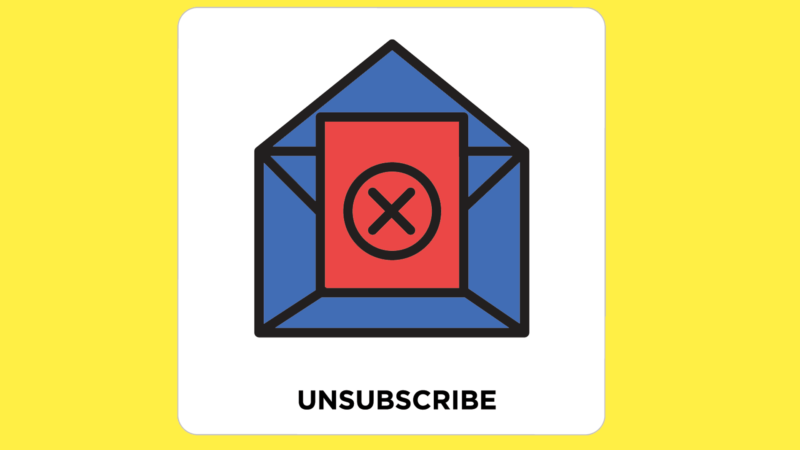The best unsubscribe email is the one you don’t send
If you're still sending unsubscribe confirmations, you're likely just annoying people. Contributor Ryan Phelan offers some better options for staying in touch.

While going through my Gmail inbox the other day, I spied an email from a brand that I was tired of hearing from. I hadn’t opened emails from that brand in a long time, either. So, when Gmail’s automated unsubscribe feature asked me if I wanted to opt out, I clicked the button.
Then, I started going through the rest of my inbox to see which other brands I didn’t want to hear from anymore and unsubscribed from those, too.
After my marathon unsubscribe session, I went off to grab some coffee. When I came back to my inbox, at the top I found three new emails, all from the brands I had just unsubscribed from.
What the heck is going on, people?
I was unsubscribing because I had mentally broken my relationships with those brands. They had nothing to offer me, no value proposition and nothing important enough in the value exchange to persuade me to stay.
In short, I was saying, “Don’t email me ever again.” And what was the answer? Another email!
The unsub confirmation is obsolete
Sending an unsubscribe confirmation made sense at one time in email marketing. But that was in the mid-1990s to early 2000s, before marketers could manage their email programs on their websites instead of through list actions. That also was before we had email laws like CAN-SPAM and CASL that outlawed sending emails to people who had unsubscribed.
Back then, an unsubscribe confirmation was your only way to let your departing subscriber know you had gotten the message and would stop sending more emails.
Today, marketers who use any but the most primitive email list software can manage all their actions on a website. Instead of sending one more email, after your subscriber has told you to stop sending emails, you can confirm the transaction on a follow-up web page.
You can do a lot more on that page, too. Keep reading to find out how a confirmation page can help you keep the connection going, even if it doesn’t happen in email.
Why ‘no’ means ‘no’ in unsubscribing

Besides the technical advances in list management, there are other reasons not to send an unsubscribe email.
Like me, your unsubscribers no longer have a connection with your brand. (This is aside from the ones who need to unsubscribe and then re-subscribe to your email program so they can update their addresses, but that’s a topic for another column.)
Everyone else just wants to move on. It’s like breaking up with someone and then having that person hang around, calling and texting and whining, “Please don’t leave.”
It’s desperate and pathetic. What do you think you’ll get from this kind of email?
I’ve heard comments from marketers who say they have persuaded some unsubscribers to come back thanks to their follow-up emails. All I can say to that is, “Show me the data.”
But that doesn’t mean you can’t try to stay in touch. Here are three ways to acknowledge an unsubscribe but keep the connection going:
- Use your site’s unsubscribe page to post a compelling message reminding people of your value proposition and the benefits they get by subscribing to your messages.
- Offer them options to modify their subscriptions, either to change their frequency (“opt down”) or opt into another list that better suits their needs or interests.
- Invite them to join you on your social media channels, in your user forums or any other locations you manage where like-minded customers might gather.
The one exception to the ‘no confirmation email’ rule
These are emails you send to customers who ended a financial or legal association by unsubscribing and need date-stamped proof that they ended the relationship.
If you offer a paid service, like a paid or recurring subscription service, this kind of email reassures the customer by confirming that their financial obligation is over.
Wrapping up
As marketers, we work hard to persuade people to opt in to our email programs. An unsubscribe can feel like a betrayal. But actually, it’s more likely an indicator of bad targeting, misaligned communication or simply a sign that your subscriber has moved on.
Don’t be sad about unsubscribes, unless you notice they’re coming from your newly-signed-up subscribers. Don’t send them a goodbye email after unsubscribing, either. Be glad that they took the time to click your (easily found) unsub link instead of ignoring your emails, or worse, reporting them as spam.
Contributing authors are invited to create content for MarTech and are chosen for their expertise and contribution to the search community. Our contributors work under the oversight of the editorial staff and contributions are checked for quality and relevance to our readers. MarTech is owned by Semrush. Contributor was not asked to make any direct or indirect mentions of Semrush. The opinions they express are their own.
Related stories